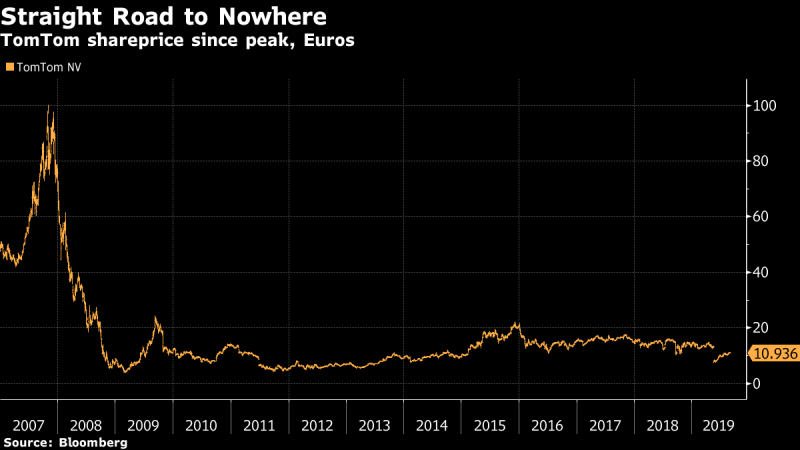
(Bloomberg) — Once a household name for its satellite navigation for cars, TomTom NV has taken a backseat in recent years as smartphones, loaded with apps like Google maps, surged in popularity.
Now the Dutch digital mapping company is betting that your car needs directions more than you do. Over the past few years, TomTom has been building high-definition or “dynamic” maps for self-driving cars. It’s a decision that could help it challenge tech platforms, like Alphabet Inc.’s Google, as cars are increasingly sold with more autonomous capabilities.
“We used to make maps for humans, but now we make maps for robots,” Alain De Taeye, member of TomTom’s management board, said at a journalist briefing in Amsterdam.
TomTom’s share price peaked in 2007 at around 100 euros a share. But this summit coincided with the launch of the iPhone. A year later, TomTom reported sales of more than 12 million personal navigation devices, it’s record high. By 2011, it announced a restructuring program that included forced lay-offs to counter lower sales and in 2017, TomTom took a 169 million-euro write down on its consumer unit. It’s share price has since hovered at around 20 euros.
TomTom now finds itself with several deep-pocketed rivals battling for the future of car navigation, including Apple Inc., Google and HERE Technologies, the digital mapping company controlled by BMW AG and other German car makers. In a blow for TomTom, longtime partner Renault SA and associates Nissan Motor Co. and Mitsubishi Motors Corp. last year signed on with Google’s Android operating system to supply standard-definition maps.
On a quest to claw its way back, TomTom is ditching unwanted business lines, like the Telematics fleet-management business, and doubling down on HD maps. TomTom says it’s been able to differentiate itself from competitors on HD maps by being independent and not having an advertising-based business model like Google’s.
In addition to sensors and other features, HD maps are an important part of autonomous driving, which can incorporate different levels of human assistance – from very little to none whatsoever in even the harshest weather conditions.
HD maps, stored on a car’s computer system, replicate every lane, guard-rail, road edge and pole that a vehicle sees, helping cars locate their positions within centimeters. Those features are critical to avoid crashing into nearby cars, but they also help the car discern which traffic light at a busy cross-section it should obey or identify a speed sign hidden by a truck.
So far, TomTom has publicly announced HD partnerships with Baidu Inc. on its Apollo driverless project, and with Renault on the carmaker’s SYMBIOZ autonomous driving program. It announced in March that it had won multiple deals to provide HD maps to major car makers, but declined to say which ones. Those contracts, which typically last more than 10 years because of ongoing service needs, have so far resulted in a roughly 60% market share in HD maps for TomTom, according to Willem Strijbosch, the company’s head of autonomous driving.
“Not every car maker has made their decision yet on who will support them on HD maps,” said Strijbosch. “But out of all the car makers that have made a decision, we see that the big ones – the top 10 – are picking TomTom.”
TomTom collects traffic and road data on more than 67 million kilometers around the world using 600 million different devices – including its mobile mapping cars, sat navs, and mobile phones. Of those roads, TomTom has so far covered only 400,000 kilometers in HD. Its HD maps are currently only available on highways in the U.S., Canada, Europe, South Korea and Japan but it is working to add more side roads as the technology advances.
The mapping firm doesn’t disclose revenue from HD maps but in July it boosted its full-year guidance, saying it now expects sales from its location technology to grow 17% to 435 million euros, up from 430 million euros forecast in April. That amounts to around two-thirds of the group’s overall expected revenue.
“The single biggest risk to the TomTom investment case is costs,” said Wim Gille, head of equity research at ABN AMRO. He said the company still has lots of ground to cover on HD maps compared to its standard definition maps and clients will want reassurance that the company can continue to serve them in a decade from now.
While HERE is out-earning TomTom in revenues, Gille said, it’s also spending around 1 billion euros a year in operating expenses, about twice as much as TomTom. Still, he said both companies have what it takes to build and maintain an HD map.
“The market is big enough for both of them,” he said.
To contact the reporter on this story: Natalia Drozdiak in Brussels at [email protected]
To contact the editors responsible for this story: Giles Turner at [email protected], Molly Schuetz
<p class="canvas-atom canvas-text Mb(1.0em) Mb(0)–sm Mt(0.8em)–sm" type="text" content="For more articles like this, please visit us at bloomberg.com” data-reactid=”39″>For more articles like this, please visit us at bloomberg.com
©2019 Bloomberg L.P.











Add Comment